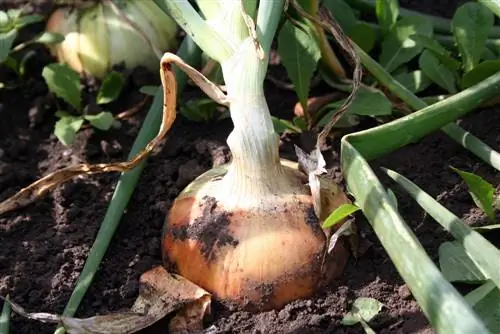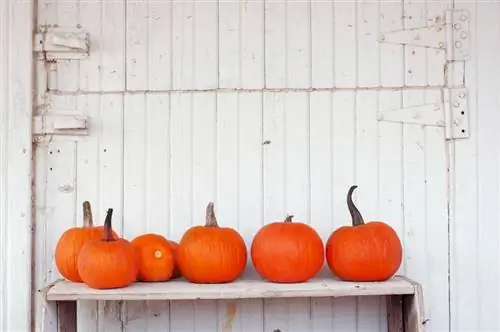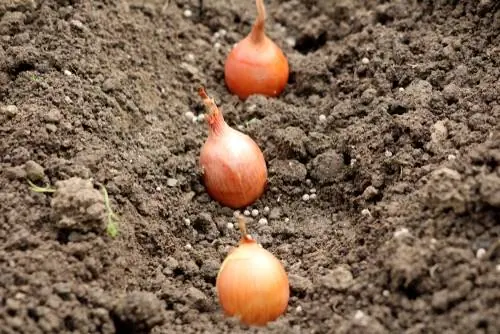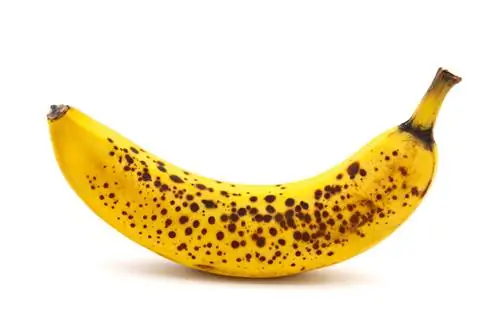- Author admin [email protected].
- Public 2024-01-02 03:03.
- Last modified 2025-01-23 11:21.
Anyone who grows onions needs a little patience, because onions usually need at least four months from sowing to mature. However, the time varies from variety to variety and depends on whether winter or summer bulbs were planted.
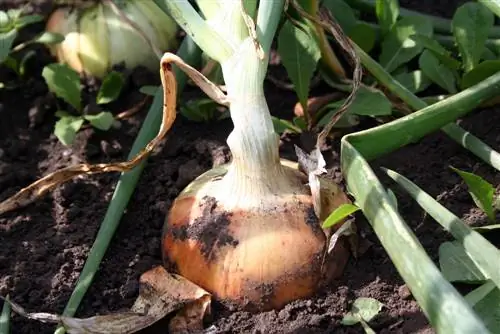
When and how should onions be harvested?
Onions are ready to harvest when most of the onion leaves have turned yellow and are bent over. Harvesting is done carefully with a digging fork and then dried for about 14 days. Store the onions in airy baskets in a dark, dry place.
When are which onions harvested?
The harvest time of the different onion varieties also varies depending on the sowing date.
- Onion sets, planted in March and April, can be harvested from around the end of July until September
- Onion sets planted in September and October can be harvested the following year from around the end of June
- Seed onions sown in March or April ripen from August to September
- Seed onions sown in August ripen from June to July of the following year
How to recognize maturity?
In midsummer, the finished onion prepares for winter. It now stores all the nutrients in the tuber. However, this means that the tubular leaves are no longer adequately supplied. As a result, they slowly die. The tip of the leaf begins to turn yellow and dry out. This process continues slowly downwards. If the gardener observes this process, he can use the digging fork to speed up the death of the onion leaves a little. He carefully pokes the soil under the bulbs and lifts the bulbs a little. This measure loosens the roots from the ground and means they can no longer absorb water. Therefore, they then stop growing and the onion greens no longer receive any nutrients at all. Within a short time, the tubular leaves of the onion died completely.
The twisting of the leaves
Even if you don't use a digging fork, you can tell when the onion is ripe because the onion leaves have almost completely yellowed and may even have already collapsed. The previously common practice of twisting the still green leaves is not recommended. It should result in faster ripening, but the opposite is true. The onion does not ripen properly and only reaches “emergency ripeness”. This has a negative effect on later storage. This measure makes it easy for pathogens to penetrate and the onion begins to rot.
How are onions harvested?
If the tubular leaves of the onions are yellowed and already bent over, it is time to harvest. The best way to do this is to choose a dry, preferably sunny day so that the onions can be easily pulled out of the ground. But even during a humid weather period, the ripe onions have to be taken out of the ground, otherwise they will begin to rot. The soil-encrusted, wet onions then require a longer drying phase.
- Take a digging fork (€139.00 on Amazon) and use it to carefully lift the onions out of the ground.
- During a dry period, you can leave the bulbs on the land to dry out.
- If the summer tends to be rainy, shake the excess soil from the harvested onions and store them in airy boxes or on wooden racks.
- If you have a covered drying facility, you can hang the onions in bunches under the roof to dry.
The drying phase should be completed after about fourteen days.
Storing the onions
After drying, there should be no more moisture in the onion leaves, the outer onion skins are “rustling dry”. Now the harvest can be stored. To do this, proceed as follows:
- Shake the excess soil from the bulb, gently helping with your hands.
- Trim the dry roots.
- Cut off the dry leaves to a length of 5 cm.
- Put the onions in an airy basket.
- Avoid closed plastic containers.
- Store the onions in a dry, airy and dark place. Basements and unheated pantries are suitable.

